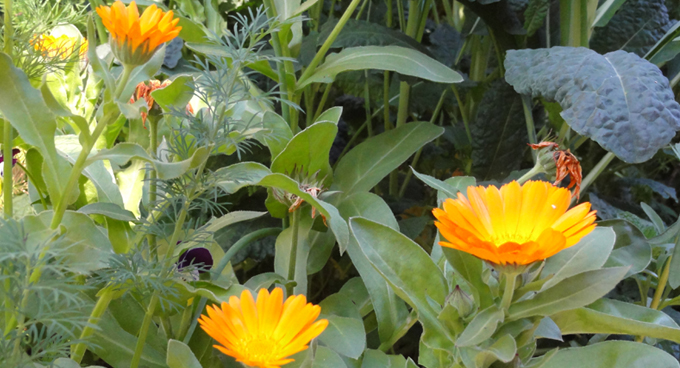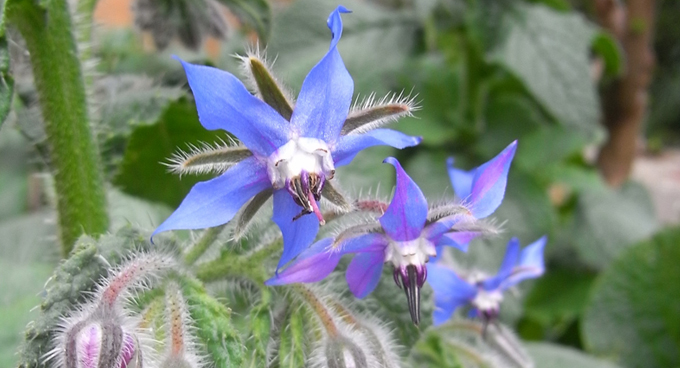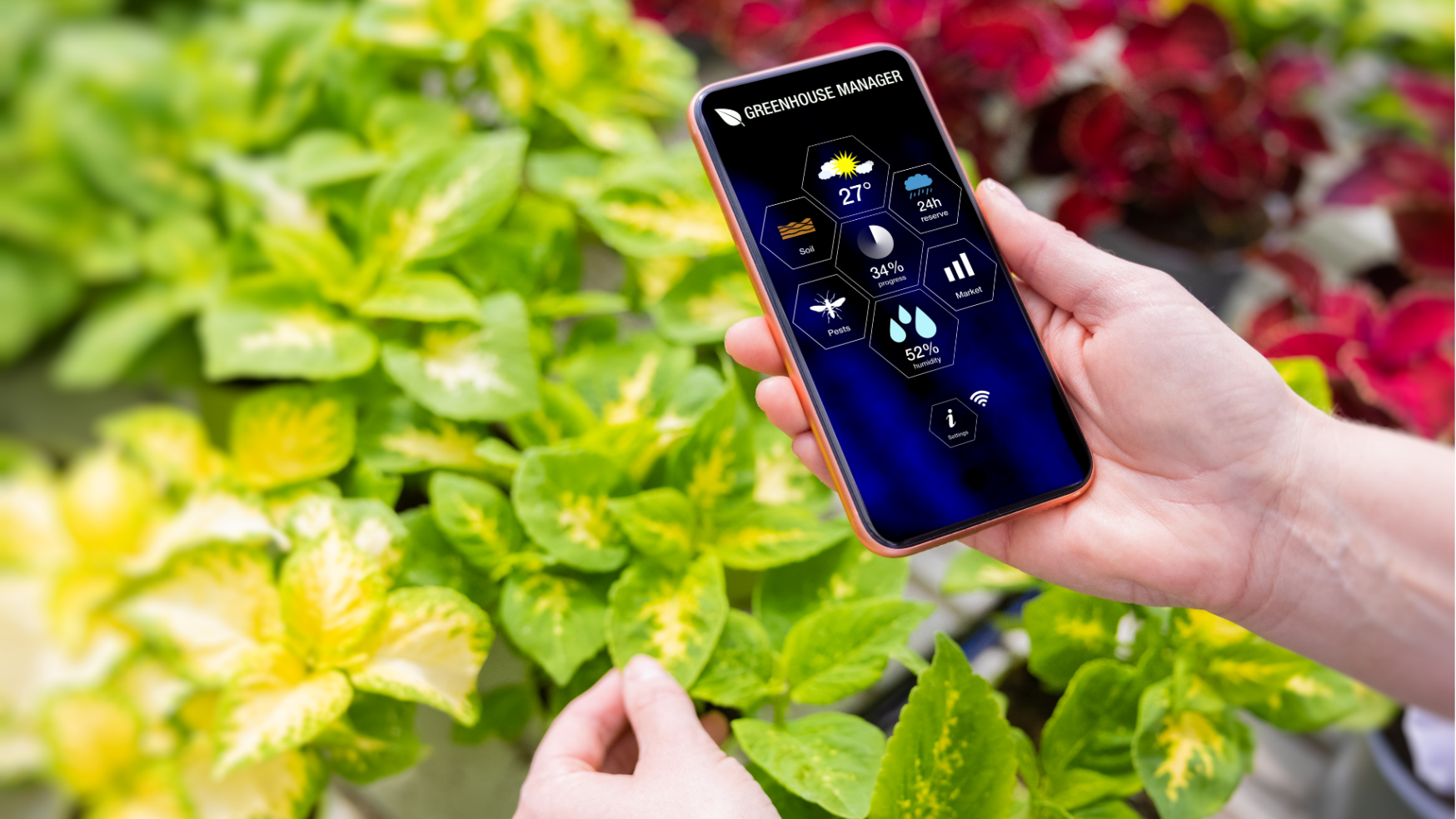Once the realm of the hardcore, hippy, home gardener, companion planting is now an incredibly popular practice – from beginner gardeners right up to large-scale agriculture. But, despite its popularity (it is huge in Europe), companion planting is often misunderstood, misused and misrepresented as the “cure-all solution” to problems in the patch.
So what is companion planting? Essentially, it’s a method of growing plants together, with the idea that they will assist each other in some way, like deterring pests, improving growth, enhancing flavour, attracting beneficial insects, fixing nitrogen, disrupting “patterns” and trap cropping. But, just as we have good neighbours, there are bad neighbours as well. Some plants really dislike each other, and shouldn’t be planted in close quarters, lest one of them struggle or meet its untimely demise.

Mythbusters – Does it Actually Work?
Now, the “Big Question”: does it work? Well, yes and no. There is a fairly limited amount of actual scientific information on companion planting, but it is safe to say that some combinations do seem to work, while others can be a bit hit and miss. Why? Well, for starters, companion planting is a northern hemisphere concept that works a treat up there, but not as well down here in Australia.
Secondly, it doesn’t work so well because it isn’t understood. We’ve all heard that basil and tomatoes should be planted together, but why? How many of each is required? Is one basil per tomato enough? Who benefits? What are we deterring? Does it enhance flavour? For years, I planted one basil plant next to each of my tomatoes, and guess what? Nothing happened. There was no discernable difference in taste. Nothing seemed to be encouraged or deterred. Nothing grew better or worse than it had before, there was simply no advantage, other than me not having to walk so far to make a pasta sauce!
 Do you know why? Because, for basil to successfully repel flies from tomatoes, an absolute shovel-load of basil is required in your patch. I’m talking several basil plants for each tomato, and even then it won’t repel fruit fly. I love basil as much as the next gardener, but I don’t love it that much, and, to be honest, I’ve never had an issue with flies on my tomatoes. But who knew this? And how many of us think that this is the quick fix for all our garden woes?
Do you know why? Because, for basil to successfully repel flies from tomatoes, an absolute shovel-load of basil is required in your patch. I’m talking several basil plants for each tomato, and even then it won’t repel fruit fly. I love basil as much as the next gardener, but I don’t love it that much, and, to be honest, I’ve never had an issue with flies on my tomatoes. But who knew this? And how many of us think that this is the quick fix for all our garden woes?
Get Your Fix – Companions that Work!
Well, companion planting CAN be the quick fix, and here’s how: biodiversity! The best thing about companion planting is that it increases the biodiversity of your patch; that is, the variety of life forms in your garden. Some of the greatest companion plants in my garden are those which have nothing to do with my vegetable patch, but are the awesome locally native trees and shrubs I have planted about the place. Clever planning (if I do say so myself) has meant that my garden is never without blossom, and is therefore never without the array of critters that come with that: birds, pollinating insects (like butterflies, bees, and native wasps), reptiles, beetles and all sorts of helpful garden buddies.
By encouraging this assortment of good guys, my garden is almost completely without the bad guys, who never get a foothold in numbers that matter to me anyway! Remember, a lettuce leaf with a hole in it doesn’t require chemical warfare, nor does it signal an attack of the dreaded munchies! So now that I’ve put you off companion planting all together, let me say that I reckon there are some combinations that really work, especially those that involve plants that have a fair odour to them. Also, there are definitely combinations that dislike each other, so I’ve made for you, dear readers, what is possibly the most comprehensive companion planting chart in the known universe.
Sustainable Gardening Australia presents:
The most comprehensive companion planting chart in the known universe (maybe)
| Plant | Good Neighbours | How it works | Bad Neighbours |
| Apple | Nasturtium, Chives | Nasturtium climbs tree and is said to repel codling moth | Potatoes |
| Apricot | Basil, Tansy, Asparagus | Basil and tansy are said to repel damaging insects | |
| Asparagus | Apricot, Basil, Chives, Comfrey, Lovage, Marjoram, Parsley, Tomatoes | Basil and Parsley are said to improve flavour. Onions and garlic release substances reducing growth. | Garlic, Onions |
| Balm (Lemon) | Tomatoes | Attracts bees, said to enhance flavour and growth | |
| Basil | Tomatoes | Basil said to repel flies and mosquitoes | |
| Beans (climbing) | Broccoli, Brussel Sprouts, Cabbage, Carrots, Cauliflower, Corn, Lettuce, Lovage, Majoram, Parsley | Beetroot, Chives, Garlic, Gladiolus, Onions, Sunflower | |
| Beetroot | Beans (bush), Broccoli, Brussel Sprouts, Cabbage, Cauliflower, Kohl Rabi, Lettuce, Lovage, Marjoram, Onion, Peas, Potato, Spinach, Silverbeet | Bad Neighbours roots release substances reducing growth | Beans (Climbing), Tomato |
| Borage | Squash, Strawberries, Tomato | Said to deter tomato worm and improve tomato flavour and yield. Said to increase strawberry yield. | |
| Brassicas (Incl: Broccoli, Cabbage, Cauliflower) | Beans, Beetroot, Carrots, Chamomile, Coriander, Cucumber, Dill, Lettuce, Lovage, Marjoram, Marigold (French), Mint, Nasturtium, Pea, Potato, Rosemary, Sage, Tansy, Thyme, Zinnias, Land Cress | Dill attracts a Cabbage White Butterfly controlling wasp. Nasturtium disguises and repels aphids. Sage repels the Cabbage White Butterfly. Zinnias attract ladybirds, which we love! Bad Neighbours’ roots release substances reducing growth. Land cress attracts Cabbage White Butterfly which lays eggs – when larvae hatch and eat it they die. | Garlic, Rue, Strawberry |
| Capsicum, Chilli | Carrots, Onions, Tomato | ||
| Carrots | Beans, Chives, Coriander, Cucumber, Leeks, Lettuce, Lovage, Marjoram, Onion, Pea, Radish, Rosemary, Sage, Tomato | Bad Neighbours’ roots release substances reducing growth | Dill, Celery |
| Celery | Cabbage, Chives, Dill, Dwarf Beans, Leek, Lovage, Majoram, Onion, Pea, Sage, Spinach, Tomato | Bad Neighbours’ roots release substances reducing growth | Carrots, Parsnip, Potato |
| Chamomile | Cabbage, Onion | Deters flies and mosquitoes. Strengthens neighbouring plants | |
| Chives | Apples, Cucumbers, Lettuce, Peas | Prevents Apple Scab. Said to deter aphids | Beans |
| Cucumber | Basil, Beans, Borage, Broccoli, Brussel Sprouts, Cabbage, Carrot, Cauliflower, Corn, Dill, Kohl Rabi, Lettuce, Lovage, Marjoram, Nasturtium, Parsnip, Pea, Radish, Sunflower, Tansy | Bad Neighbours’ roots release substances reducing growth | Potato, Sage, Strongly Aromatic Herbs |
| Dill | Brassicas (Incl: Broccoli, Cabbage, Cauliflower) | Dill attracts a Cabbage White Butterfly controlling wasp | |
| Eggplant | Beans, Spinach | ||
| Garlic | Apricot, Cherry, Mulberry, Parsnip, Peach, Pear, Raspberry, Rosemary, Rose | Deters aphids, especially from roses and raspberry. Repels Cabbage White Butterfly | Beans, Cabbage, Peas, Strawberry |
| Kohl Rabi | Beetroot, Onion | Beans, Tomato | |
| Leek | Carrot, Celery, Lovage, Majoram, Onion, Parsnip, Strawberry | Beans, Peas, Parsley | |
| Lettuce | Achillea, Beans, Beetroot, Cabbage, Carrot, Chervil, Coreopsis, Cucumber, Lovage, Marjoram, Marigold (French), Onion, Parsnip, Pea, Radish, Strawberry, Zinnia | Achillea, Coreopsis & Zinnia attract pollinators and offer shade for lettuce | Parsley |
| Marigolds (French) | Numerous vegetables, including tomato | Kills root knot nematodes and eel worm | |
| Melon | Radish, Sweet Corn | ||
| Mint | Cabbage, Tomato | Deters pests such as Cabbage White Butterfly, ants and fleas | |
| Nasturtium | Cabbages, Fruit Trees, Radishes, Zucchini | Flowers repel aphids and codling moth. Cabbage White Butterfly is attracted to this plant, and will seek it out over cabbages | |
| Onion | Beetroot, Broccoli, Cabbage, Carrot, Chamomile, Leeks, Lettuce, Lovage, Marjoram, Parsley, Parsnip, Silverbeet, Strawberry, Summer Savory, Tomato | Smell of onion said to deter numerous pests. Onions release substances reducing growth of Bad Neighbours | Asparagus, Beans, Gladioli, Peas |
| Parsley | Asparagus, Sweet Corn, Tomato | Said to improve flavour of asparagus and tomato | |
| Peas | Beans, Beetroot, Brussel Sprouts, Cabbage, Carrot, Cauliflower, Celery, Cucumber, Lettuce, Lovage, Marjoram, Parsnip, Potato, Radish, Sage, Squash, Sweet Corn | Bad Neighbours’ roots release substances reducing growth. Sweet Corn has traditionally been used as “living stakes” for peas | Chives, Garlic, Onion, Shallots |
| Potato | Beans, Broccoli, Brussel Sprouts, Cabbage, Cauliflower, Corn, Eggplant, Horseradish, Lovage, Marjoram, Marigold (French), Nasturtium, Parsnip, Peas, Sweet Alyssum, Sweet Corn, Watermelon | Sweet Alyssum and Marigolds attract beneficials and suppress weeds. Potatoes release substances reducing growth of Bad Neighbours. Horseradish should be planted at the corners of the patch | Apple, Celery, Cherry, Cucumber, Pumpkin, Raspberry, Rosemary, Squash, Sunflower, Tomato |
| Pumpkin | Beans, Cabbage, Eggplant, Peas, Radish, Sweet Corn | Bad Neighbours’ roots release substances reducing growth | Potato |
| Radish | Beans, Carrot, Chervil, Cucumber, Sweet Corn, Cucumber, Lettuce, Lovage, Marjoram, Nasturtium, Parsnip, Pea, Spinach, Sweet Corn | Radish is said to attract leaf miners from Spinach | Hyssop |
| Raspberry | Blackberries, Potato, Tomato | ||
| Rosemary | Beans, Cabbage, Carrot, Sage | ||
| Sage | Brassicas (Incl: Broccoli, Cabbage, Cauliflower), Carrot, Rosemary | Sage repels the Cabbage White Butterfly | Cucumber |
| Silverbeet | Beetroot, Cherry, Lavender, Lovage, Marjoram, Onion | Basil, Wormwood | |
| Spinach | Celery, Eggplant, Strawberries | ||
| Squash | Borage, Lovage, Marjoram, Nasturtium, Peas, Sunflower, Sweet Corn, Tansy | Potato | |
| Strawberry | Beans, Borage, Chives, Leek, Lettuce, Marigold (French), Onion, Pyrethrum, Sage, Spinach | Brassicas (Incl: Broccoli, Cabbage, Cauliflower), Brussel Sprouts, Garlic | |
| Sunflower | Apricots, Cucumbers, Squash | Beans, Potato | |
| Sweet Corn | Beans, Cucumbers, Lovage, Marjoram, Melon, Parsnip, Peas, Potato, Pumpkin, Radish, Squash, Zucchini | Sweet Corn has traditionally been used as “living stakes” for peas. Bad Neighbours’ roots release substances reducing growth | Cabbage |
| Tomato | Asparagus, Basil, Celery, Borage, Broccoli, Brussel Sprouts, Cabbage, Carrot, Cauliflower, Celery, Chives, Dill, Gooseberry, Grape, Hyssop, Lovage, Marigold (French), Marjoram, Mint, Nasturtium, Onion, Parsley, Parsnip, Turnip | Marigolds said to repel white fly and root knot nematode. Bad Neighbours’ roots release substances reducing growth | Apricots, Beetroot, Fennel, Kohl Rabi, Potato, Rosemary, Sweet Corn |
| Turnip | Cucumbers, Lettuce, Nasturtium, Peas, Tomato | ||
| Watermelon | Potato | ||
| Yarrow | Most aromatic herbs | When planted along pathways, is said to enhance essential oil production and herb flavour. | |
| Zucchini | Lovage, Marjoram, Nasturtium, Sweet Corn |
and…
a couple of general plants that make great companions for other reasons
- Basil helps repel flies and mosquitoes.
- Borage in the strawberry patch will increase the yield.
- Catnip repels fleas, ants and rodents.
- Caraway helps breakdown heavy soils.
- Chamomile deters flies and mosquitoes and gives strength to any plant growing nearby.
- Chives grown beneath apple trees will help to prevent apple scab; beneath roses will keep away aphids and blackspot.
- Elderberry a general insecticide, the leaves encourage compost fermentation, the flowers and berries make lovely wine!
- Fennel (not F. vulgare or F.officionale) repels flies, fleas and ants.
- French Marigold root secretions kill nematodes in the soil. Will repel white fly amongst tomatoes.
- Garlic helps keep aphids away from roses.
- Hyssop attracts cabbage white moth keeping brassicas free from infestation.
- Mint repels cabbage white moth. Dried and placed with clothes will repel clothes moth.
- Nasturtium secrete a mustard oil, which many insects find attractive and will seek out, particularly the cabbage white moth. Alternatively, the flowers repel aphids and the cucumber beetle. The climbing variety grown up apple trees will repel codling moth.
- Pyrethrum will repel bugs if grown around the vegetable garden.
- Rosemary repels carrot fly.
- Rue (Rutus, not Peganum) keeps cats and dogs off garden beds if planted round the borders.
- Sage protects cabbages from cabbage white moth.
- Tansy (Tanacetum, not Senecio) repels moths, flies and ants. Plant beneath peach trees to repel harmful flying insects. Tansy leaves assist compost fermentation.
- Wormwood (Artemesia, not Ambrosia) although it can inhibit the growth of plants near it, wormwood does repel moths, flies and fleas and keeps animals off the garden.
Information sources:
Bagnall, Lyn, Easy organic gardening and moon planting, published by Scribe Publications, VIC.
www.figtree.org.au.
Pictures
Companion Planting pic: Elaine Shallue (SGA)
Borage pic: Elaine Shallue (SGA)
Related Articles:
Citizen Science: A Pathway to Gardening Success and Biodiversity Conservation
In recent years, the realm of science has experienced a remarkable transformation, one that invites people from all walks of life to participate…
A Sustainable Gardener’s Guide to Thrifty Gardening
Creating an eco-friendly and cost-effective garden involves more than just nurturing plants; it's about adopting a sustainable approach that…



